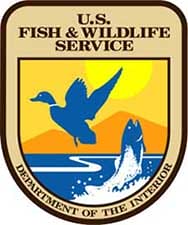

Washington, DC -(Ammoland.com)- The U.S. Fish and Wildlife Service (USFWS) today announced federal protection for the rufa subspecies of the red knot, a robin-sized shorebird, designating it as threatened under the Endangered Species Act.
A “threatened” designation means a species is at risk of becoming endangered throughout all or a significant portion of its range.
“The red knot is a remarkable and resilient bird known to migrate thousands of miles a year from the Canadian Arctic to the southern tip of South America,” said Service Director Dan Ashe. “Unfortunately, this hearty shorebird is no match for the widespread effects of emerging challenges like climate change and coastal development, coupled with the historic impacts of horseshoe crab overharvesting, which have sharply reduced its population in recent decades.”
Since the 1980s, the knot’s population has fallen by about 75 percent in some key areas, largely due to declines in one of its primary food resources – horseshoe crab eggs in Delaware Bay, an important migratory stopover site. Although this threat is now being addressed by extensive state and federal management actions, other threats, including sea-level rise, some shoreline projects and coastal development, continue to shrink the shorebird’s wintering and migratory habitat.
Changing climate conditions are also altering the bird’s breeding habitat in the Arctic and affecting its food supply across its range, in particular through climate-driven mismatches in migration timing that affect the peak periods of food availability. The bird must arrive at Delaware Bay at exactly the time when horseshoe crabs are laying their eggs.
“Although historic threats in the Delaware Bay area have been ameliorated thanks to the actions of federal and state partners, our changing climate is posing new and complex challenges to the red knot’s habitat and food supply,” Ashe said. “It has never been more critical that we take positive action to save this bird.”
One of the longest distance migrants in the animal kingdom, some rufa red knots fly more than 18,000 miles each year between breeding grounds in the Canadian Arctic and wintering grounds along the Gulf Coast, southeast
United States and South America. One bird, banded by biologists in 1995 in Argentina, has been nicknamed Moonbird because he has flown the equivalent of a trip to the moon and at least halfway back in his 21 or more years of migrations.
Along its epic migration, the red knot, which can be identified by its rufous breast, belly and flanks during breeding season, can be found across 27 countries and 40 U.S. states in flocks ranging from a few individuals to several thousand. Although rufa red knots mainly occur along the Atlantic and Gulf coasts, small groups regularly use some interior areas of the United States during migration. The largest concentration of rufa red knots is found in May in Delaware Bay, where the birds stop to gorge themselves on the eggs of spawning horseshoe crabs; a spectacle drawing thousands of birdwatchers to the area. In just a few days, the birds nearly double their weight to prepare for the final leg of their long journey to the Arctic.
International, state and local governments, the conservation community, beachgoers and land managers are helping ensure red knots have safe areas to winter, rest and feed during their long migrations. These partners help knots in a variety of ways, including managing the harvest of horseshoe crabs (which are caught for use as bait in conch and eel pots), managing disturbance in key habitats, improving management of hunting outside the United States, and collecting data to better understand these birds.
In making its decision, the Service analyzed the best available data in more than 1,700 scientific documents, and considered issues raised in more than 17,400 comments provided during 130 days of public comment periods and
three public hearings. Protections under the ESA will take effect 30 days after publication in the *Federal Register*.
As required by the ESA, the Service is also reviewing the U.S. range of the rufa red knot to identify areas that are essential for its conservation, known as critical habitat. The Service expects to propose critical habitat for the rufa red knot for public review and comment in 2015 after completing the required review of economic considerations.
Visit www.fws.gov/northeast/redknot/ to read the final rule and response to comments; view and download video, photos and maps; and explore more resources, such as an interactive timeline and infographic. The rule will be available at www.regulations.gov on December 11, 2014, under docket number FWS-R5-ES-2013-0097.
About the U.S. Fish and Wildlife Service (USFWS)
The mission of the U.S. Fish and Wildlife Service is working with others to conserve, protect, and enhance fish, wildlife, plants, and their habitats for the continuing benefit of the American people. We are both a leader and trusted partner in fish and wildlife conservation, known for our scientific excellence, stewardship of lands and natural resources, dedicated professionals, and commitment to public service. For more information on our work and the people who make it happen, visit www.fws.gov.
